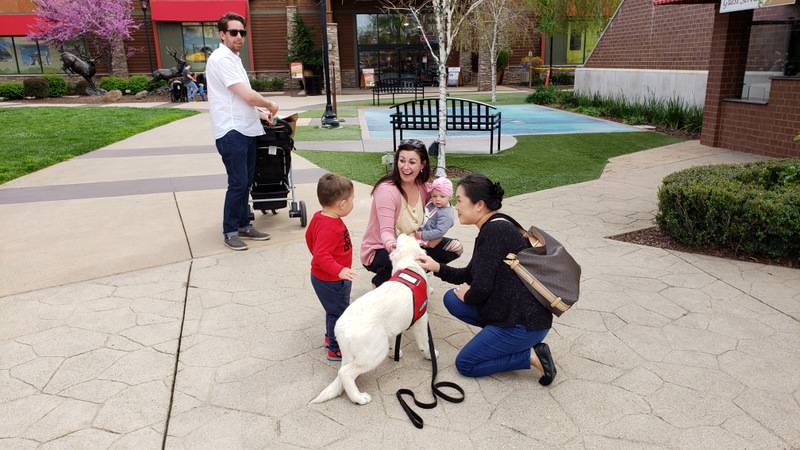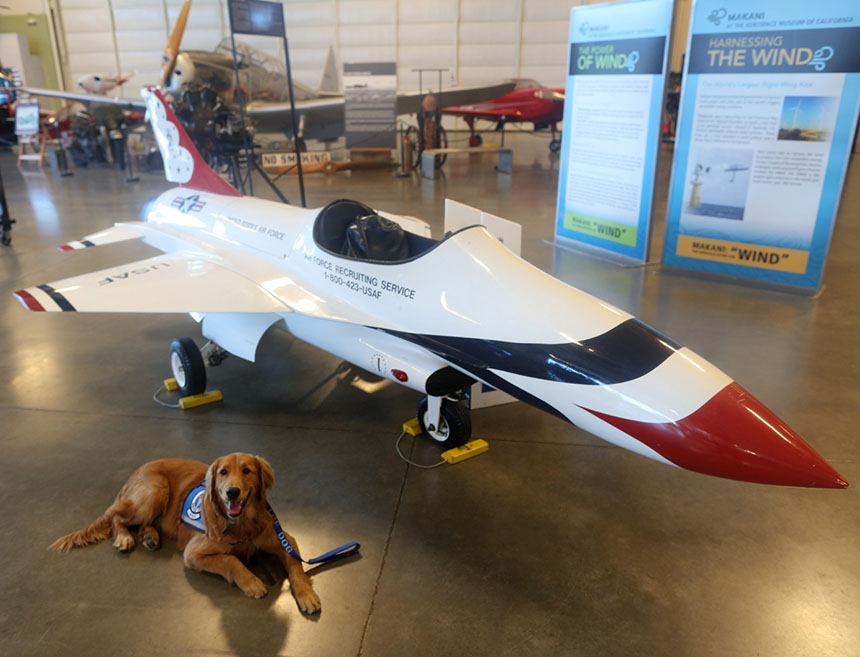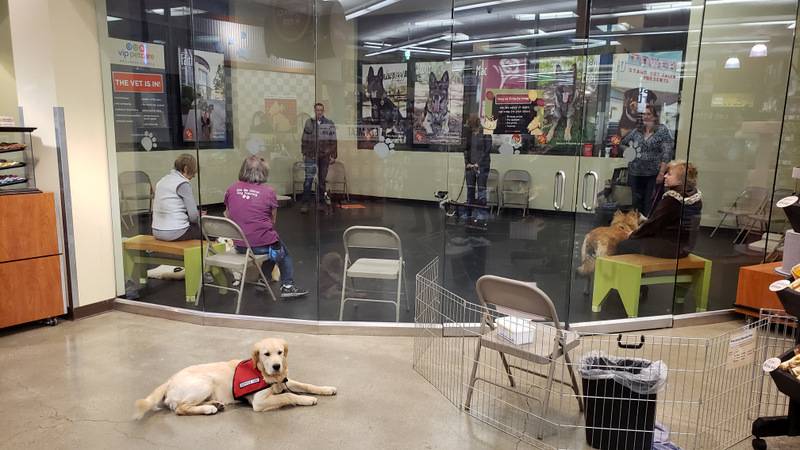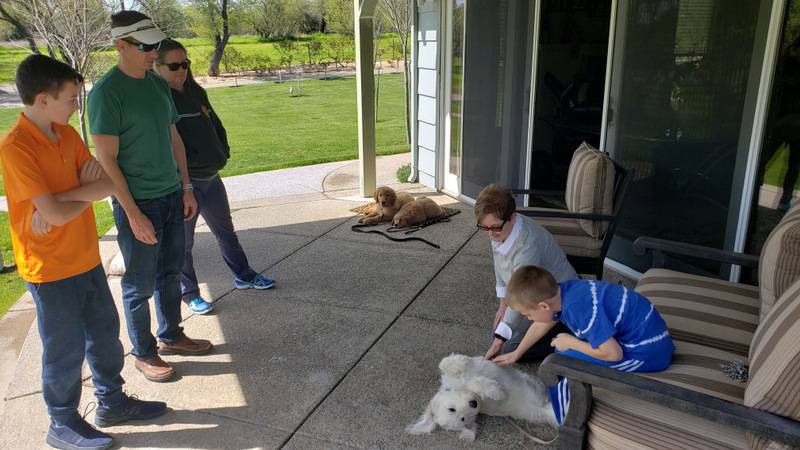Mental Health Professionals such as Psychologists, Social Workers (LCSW) and Marriage Family Therapists (MFT) use Therapy Dogs in their practices.

Don’t be so self-conscious. Get a fully-trained therapy dog for your practice!
We wrote this page to make available reliable information about Therapy Dogs and therapy dog training that licensed mental health counselors can rely on.
A Therapy Dog is dog that is trained for Public Access that makes others feel better or more at ease. Many people train their pet dog to work as a therapy dog, but most dog owners to not have the skills or knowledge to train a dog to be calm enough to actually go into a public setting or to get their dog to lay there in a counseling session for an hour or longer.
Therapy dogs are also dogs who go with their handlers or owners to volunteer in settings such as schools, hospitals, and nursing homes and usually need an extraordinary level of obedience compared to most peoples’ pets.
Therapy dogs should not be confused with service dogs. To legally qualify to have a service dog, somebody must have a disability that substantially limits his/her ability to perform at least one major life task without assistance. To legally qualify as a service dog, the dog must be individually trained to perform that major life task. The dogs who become Therapy Dogs do not have the same public access rights as service dogs. A dog cannot be a service dog unless it has been specifically trained for Public Access.
It is illegal to attempt to pass off a therapy dog as a service dog for purposes such as flying on a plane or being admitted to a restaurant.
Instructions for ‘How To Get A Service Dog’
1. Read our website.
2. Get to know us on Facebook and see 100’s of dogs we trained.
3. Submit a Service Dog Application
Requirements of Therapy Dogs For Sale
Therapy dogs bought and used by mental health professions are not house pets that are trained by an amateur. Therapy dogs need specialized therapy dog training. Certification, registration, or documentation is usually done by a business, such as a hospital, school or mental health clinic that emoploys the licensee. Dogs must be well mannered and under the control of their handlers at all times.
Requirement 1: A therapy dog must be a friendly dog. Any mix or breed can be trained to provide comfort and affection to people in hospitals, retirement homes, schools, mental health institutions, airports, and many other settings. Certain organizations my require therapy dogs to be at least one year old, while some organization allow young puppies trained as therapy dogs.
Requirement 2: Someone usually formally tests the dog to make sure it has a suitable temperament and has good manners and demeanor. At this time, the handler is usually also tested to determing proficiency handling their dog.
Requirement 3: Therapy Dog teams are constantly monitored and sometimes re-tested frequently to make sure liability is kept to a minimum because dogs are animals and have minds of their own. Frequently testing working therapy dog teams greatly reduces potential liability for handlers and organizations

NOTE: Due to liability concerns, most organizations require therapy dogs to be fully certified and temperament tested (unlike emotional support animal training, which is only heavily encouraged).
Public Access training for a Therapy Dog is paramount because the animals have to make contact with unfamiliar people in often-stressful environments. The most important characteristic of a therapy dog is its temperament.
Therapy dogs must have a calm and stable temperament and be able to tolerate children, other animals, crowded public places, people with mental or physical problems that can scare dogs, and other situations that are be stressful, without becoming distressed, fearful or aggressive.
A good therapy dog must be friendly, confident, gentle in all situations and must be comfortable and contented with being petted and handled, sometimes clumsily.
Types of Therapy Dogs
A therapy dog is a dog trained to provide affection and a sense of comfort to individuals in hospitals, retirement homes, nursing homes, schools, hospices, people with learning difficulties, and stressful situations, such as disaster areas. Research suggests that interactions with therapy dogs can increase oxytocin levels (responsible for bonding) and dopamine (responsible for happiness) while lowering levels of cortisol (that comes from stress).
There are three different types of therapy dogs:
- The first (and most common) are “Therapeutic Visitation” dogs. These dogs are household pets whose owners take time to visit hospitals, nursing homes, and rehabilitation facilities. These dogs help individuals who have to be stuck away from home due to mental or physical illness. A visit from a visitation dog can brighten their day, lift their spirits, and help motivate them in their therapy or treatment with the goal of going home.
- The second type of therapy dog is called an “Animal Assisted Therapy” dog. These dogs assist physical and occupational therapists in meeting goals important to an individual’s recovery. Some tasks that these dogs can help to achieve include gaining motion in limbs, fine motor control, and hand-eye coordination. Animal Assisted Therapy dogs typically work in rehabilitation facilities.
- The last type of therapy dog is called a “Facility Therapy Dog.” These dogs primarily work in nursing homes and are often trained to help keep patients with Alzheimer’s disease or other mental illness from getting into trouble. They are handled by a trained member of the staff and live at the facility.
Therapeutic Visitation Dogs
Therapeutic visitation dogs, commonly referred to as simply “therapy dogs” – is the most widely used method of animal therapy. These dogs are usually household pets that make visits with their owner, referred to as a volunteer handler. Together, the dog and the handler work as a team to reach beyond traditional forms of therapeutic healing and treatment.
Animal-assisted therapy dogs are companion animals, usually dogs, that provide opportunities for motivation, education, or recreation to improve a person’s quality of life. In such therapies, these animals are an integral part of the treatment process and meant to improve the physical, social, emotional, and cognitive functions of humans. Animal-assisted therapy (AAT) as a conceptual term in medicine is relatively new. AAT’s origins come from many disciplines including psychology, sociology, psychiatry, and veterinary medicine. AAT dates back to ancient Greece and where companion animals were used to help people overcome physical and mental illnesses. The Greek doctor Hippocrates considered the activity of horseback riding to be relaxing and thought it had a therapeutic value which could help people with incurable ailments.
Disaster Relief Dogs
Therapy dogs operate in non-emergency environments. A college library packed with stressed students during finals – an environment that is definitely tense is very different from an active emergency. Comfort (or “crisis response”) dogs work during active crises and in emergency situations—both natural and manmade. They can offer a calming presence and a welcome distraction to those who have been impacted by disasters, often in shelters or in common public gathering spaces.
Facility Therapy Dogs
A Facility Therapy Dog is a highly trained and skilled therapy dog used to help make the quality of life and education for children and adults with disabilities or special needs and Seniors. Facility dogs are handled by professionals and can be used to assist a select group of clients better manage their daily tasks. Facility Therapy Dogs typically work hand-in-hand with Therapists, Counselors, Guidance Counselors, Psychologists and Rehabilitation Therapists.
Facility Dog – Key Benefits
Encourage Physical Movement, Verbal and Non-Verbal Communication & Improved Social Behavior
- Motivation:
The client responds more positively, enthusiastically, and comfortably when a dog is involved. Together, the client and the Facility Dog work together to engage in physical activities which help achieve goals set by the therapist. Since dogs offer unconditional, non-judgmental love, therapy sessions can be pleasurable as well as productive. - Recovery Motivation:
The client’s ability to move is improved and response to physical stimuli is increased. This encourages the client to engage in physical activities, often overlooking pain. - Social Interaction & Language:
Therapy dogs open dialogue and facilitate conversations that encourage social and emotional development. Therapy dogs help promote social and emotional development. - Comfort, Compassion and Care:
Facility dogs can provide support and friendship to anyone who may have the unique challenge of making new friends, or lack self-esteem. Dogs can also be used as a motivator or reward system to teach responsibility. - Feelings of Safety & Well-Being:
Therapy dogs are a calm companion who helps relieve stress, anxiety and loneliness. Dogs bring a pleasant distraction and reduce negative feelings, thoughts and concerns.
Animal Assisted Therapy Dogs
“Animal Assisted Therapy” dogs augment physical and occupational therapists in meeting goals important to a person’s physical or mental recovery.
Animal Assisted Therapy dogs typically work in physical rehabilitation facilities and common tasks include helping a patient regain limb motion, fine motor skills and regaining pet care skills for their personal pets.
Reading Therapy Dogs
Reading Therapy Dogs go with their owner/handlers into schools and public libraries where they assist children who struggle with reading.
Many children who experience reading difficulties develop self-esteem issues or become self-conscious when reading in front of classmates or parents, and the main purpose of a reading therapy dog is to lay beside a child and create a dog-friendly atmosphere that allows students to practice their reading skills in a non-judgmental environment.
Reading therapy dogs not only help children to feel more comfortable and confident when reading, but they also help students become excited about practicing his or her reading skills.

Therapy Dog Breeds
Although any size dog can make a great therapy animal, small dogs are particularly well-suited for the job because they can be easily lifted onto a person’s hospital bed, or held in the patient’s arms.
When choosing a canine to serve as a therapy dog, the most important things to consider the animal’s temperament and how easily the dog can be trained. A good therapy dog must have a calm and gentle demeanor and must enjoy human touch.
Although any breed can make a great therapy dog, some of the best breeds for therapy work are:
Small Breeds:
- Chihuahua
- Corgi
- French Bulldog
- Min Pin
- King Charles Spaniel
- Dachshund
- Bichon Frise
- Poodle
- Maltese
- Pomeranian
Large Breeds:
- Golden Retriever
- Labrador Retriever
- German Shepherd
- Goldendoodle
- Tibetan Mastiff
- Outcharka
- Poodle
- Great Dane
- Pit Bull
- Bernese Mountain Dog
Therapy Dog Training
At a minimum, the therapy dog should have the ability to complete basic obedience such as:
- Heeling or walking on a loose leash
- Down
- Sit
- Come
- Leave It
- Walking past a neutral dog
- Gently taking a treat or object
The dog should want to do the interactions. It should not be robot-like in its obedience to the point that it cannot share its personality with the client. For example, if the dog is in a session with a child on the floor reading, it should be okay for the dog to lie its head on the leg of the child. The dog should welcome petting.
Dogs should be comfortable with:
- handling of nails and paws
- grabbing scruff
- staring into the eyes
- prolonged hugs
- grabbing tail
- brushing
- yelling
- jerky movements
- several people crowding it at once
Dogs also learn how to respond to unsettling situations, unfamiliar sights, and sounds, such as:
- equipment
- loud noises
- loudspeakers
- crowds
- unusual smells
- hallways
- wheelchairs
- fire alarms
If your dog displays the following behaviors, he/she may not yet be suitable for therapy work:
- Growling, barking, or other signs of aggression toward humans
- Growling, barking, or other signs of aggression toward dogs or other animals
- Shyness
- Lack of house-training skills
- Medical concerns (advanced age, fatigue, stiffness, excessive panting, signs of discomfort, etc.)
For the person:
The handler should be trained in
- effective communication skills
- infection prevention
- proper handling of leash
- the policies and procedures of the facility
- the scope of your role in each facility
- proper hygiene and attire for you and the dog
- stress reduction and conflict management
- confidentiality
Many therapy dog organizations provide liability coverage for therapy dog team volunteers, but it is important to adhere to the organization’s policies and procedures. If you do not have coverage through an organization or are working as a professional, you may want to consider liability coverage.
Lastly, it is important to remember that you are there for the benefit of the client. You have to like what you are doing. Make sure you are comfortable with what you are asked to do. If not, speak up to protect yourself and the dog.
Therapy Dog Certification
There are many different organizations which offer therapy dog certification and/or registration, and each organization has its own standards and protocols. Most are online scammers basically just ripping off disabled people or well-meaning altruistic do-gooders that just want to help others.
However, all organizations that deal with therapy dog certification typically share common ground in their training and temperament requirements for any therapy dog candidates.
Additionally, most medical institutions require therapy dogs to be registered or certified by an their staff. Our advice is Save Your Money and contact the organization you wish to volunteer for to find out what they require. No sense in buying Therapy Dog Training that does not meet the requirements your dog will need where you ultimately work and take it.
Therapy Dog Resources
Spending time with animals produces marked improvements in humans, affecting the physical, mental, emotional and social aspects of their well-being. Stress leads to an overproduction of stress hormones, and in-turn increased blood pressure, heart rate, and chance of heart attack and stroke. As you will see in the list, below, a visit with a therapy animal does much to reverse the effects of stress.
Visiting with an animal can reduce anxiety without the need for medication, or elicit positive reminiscing in clients with progressed dementia. Therapy animal teams frequently witness measurable improvements as well, for example in visiting with chemotherapy patients in order to lower their blood pressure to a level acceptable for treatment.
Therapy Dog Benefits: Mental Health
1. Decrease in stress and anxiety, including that from post-traumatic stress disorder (PTSD)
2. Decrease in depression, loneliness and feelings of isolation
3. Decrease in aggressive behaviors
4. Increase in socialization with an outward focus, including opportunities for laughter and a sense of happiness and well-being
5. Increase in mental stimulation, attention skills, and verbal interactions
6. Increase in spirit, self-esteem, and feeling of acceptance, enabling a patient to further participate in mental and physical therapy, to be more involved in group activities, and to accept social and emotional support.
Therapy Dog Benefits: Physical Health
1. Decrease in blood pressure
2. Decrease in heart rate
3. Decrease in the stress hormone cortisol
4. Increase in hormones associated with health and a feeling of well-being, including beta-endorphin, beta-phenylethylamine, dopamine, oxytocin, prolactin and serotonin
5. Increase in level of fitness by providing stimulus for exercise, with improvement in activities in which they were limited
6. Improvement in fine motor skills, standing balance, wheelchair and other physical skills
In addition, the benefits listed above may result in a decrease in a person’s need for medications.
Although any size dog can make a great therapy animal, small dogs are particularly well-suited for the job because they can be easily lifted onto a person’s hospital bed, or held in the patient’s arms. When choosing a canine to serve as a therapy dog, the most important things to bear in mind are the animal’s temperament and how easily the dog can be trained.
A good therapy dog must have a calm and gentle demeanor and must enjoy human touch. Although any breed can make a great therapy dog, some of the best therapy dog breeds are:
Therapy Dog Training: What You Need to Know
If you have a dog, it may not need any training at all! Therapy dogs simply have to be very obedient, tolerant, and social. And your dog is all of these things, right? No. 99% of pets dogs will flunk and evaluation to be a Therapy Dog because the dog has not been trained for Public Access by a professional.
Pet dogs are brought to therapy dog evaluations the owners say are “good and well-behaved” that aren’t even close to being ready for therapy dog work. They bark and pull at other dogs, and have to be taken from the room to get them under control.
Training for the handler differs with the different therapy animal organizations. Some require that you attend a training program, while others require that you and your animal attend a training program together. Still others allow you to go directly to an evaluation. Also some organizations allow home schooling on-line or from printed materials.
Most organizations, however, require that you be evaluated by members of their own. If an organization offers a training program, it’s a great way to prepare for their evaluation. But whether they do or not, one of the best things you can do to prepare is to volunteer to assist at an evaluation and observe those being evaluated.
One of the most important things you can do during your evaluation, and in the therapy animal work you do afterward, is to be proactive. Most organizations do not treat the evaluation like an obedience trial, where a dog is to perform flawlessly with only minimal direction from its handler. In an evaluation, you are welcome to assist your animal just as you would on the job.
Here are a couple of examples of therapy dog handlers being proactive:
1. If you see another dog enter the room, tell your dog so it doesn’t feel the need to tell you with a bark. This is being proactive, rather than acting after your dog barks, which would be reactive. Or doing nothing, which would be inactive.
2. Let’s say three people are aggressively moving toward your dog and asking to pet it. That could be scary! So be proactive, and reach down and pick up your dog or bend down and physically connect with it. It will then feel secure with your contact, and should be fine being petting by any number of people.
Therapy Dogs Laws
A therapy dog is a pet trained to interact with many people other than its handler to make those people feel better. Therapy dogs are also trained to behave safely around all sorts of people, and are often certified.
A therapy dog handler is not given public access rights by any service dog laws to take the dog out everywhere like service dog users, because the handler does not have a disability the dog is individually trained to mitigate. Therapy dogs are only allowed into places like hospitals, skilled nursing facilities, and libraries by prior agreement (again, not by service dog laws).
How A Therapy Dog Can Help You
A good therapy dog must be friendly, confident, gentle in all situations and must be comfortable and contented with being petted and handled, sometimes clumsily.
Therapy dogs must have a calm and stable temperament and must be able to tolerate children, other animals, crowded public places and other situations which may be stressful, without becoming distressed or dangerous. Additionally, some institutions require that any therapy dogs working on their premises be fully insured and trained, and sometimes that they be certified by an accredited organization.
There are many different organizations which offer therapy dog certification and/or registration, and each organization has its own standards and protocols. However, all organizations that deal with therapy dog certification typically share common ground in their training and temperament requirements for any therapy dog candidates.
Additionally, some medical institutions require therapy dogs to be registered or certified by an official organization, prior to allowing the dog-handler-team to operate on their premises.
If you have an emotional support animal, it might be worth while to sign them as a therapy dog as a part-time job. It’s only an endless cycle of love, comfort, and more love.
And if you think you could benefit from an ESA first, take the pre-screening today to see if you could qualify for one.
Disclosure: Bear in mind that some of the links in this post are affiliate links and if you go through them to make a purchase CertaPet.com may earn a commission. Keep in mind that we link these companies and their products because of their quality and not because of the commission we receive from your purchases. The decision is yours, and whether or not you decide to buy something is completely up to you.
Service Dog School of America offers the #1 Therapy Dog Training for Therapy Dogs. We can tell you how to get a Therapy Dog and how to make your dog a Therapy Dog, what is the best Therapy dog, what the requirementas are, how to train a Therapy Dog, and we canhelp you find the best trainer if you are looking for the best Therapy Dog Training.
Enjoy reading this page, then. . . .
1. Submit a THERAPY DOG APPLICATION
2. CALL THE OFFICE (916)701-6458 AFTER you (a) Submit an application, and (b) Look at the dogs for sale on Facebook.








